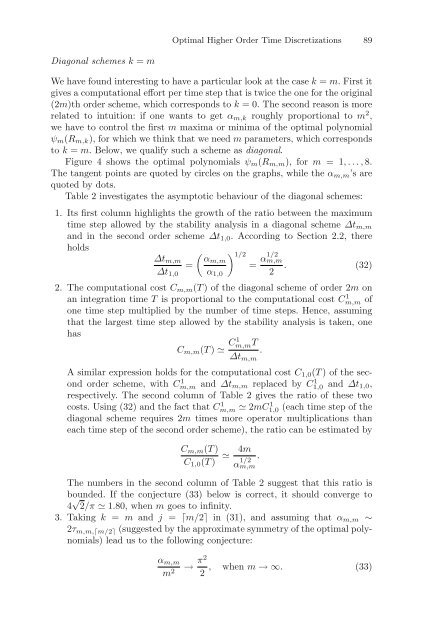Partial Differential Equations - Modelling and ... - ResearchGate
Partial Differential Equations - Modelling and ... - ResearchGate
Partial Differential Equations - Modelling and ... - ResearchGate
Create successful ePaper yourself
Turn your PDF publications into a flip-book with our unique Google optimized e-Paper software.
Optimal Higher Order Time Discretizations 89<br />
Diagonal schemes k = m<br />
We have found interesting to have a particular look at the case k = m. First it<br />
gives a computational effort per time step that is twice the one for the original<br />
(2m)th order scheme, which corresponds to k = 0. The second reason is more<br />
related to intuition: if one wants to get α m,k roughly proportional to m 2 ,<br />
we have to control the first m maxima or minima of the optimal polynomial<br />
ψ m (R m,k ), for which we think that we need m parameters, which corresponds<br />
to k = m. Below, we qualify such a scheme as diagonal.<br />
Figure 4 shows the optimal polynomials ψ m (R m,m ), for m = 1,...,8.<br />
The tangent points are quoted by circles on the graphs, while the α m,m ’s are<br />
quoted by dots.<br />
Table 2 investigates the asymptotic behaviour of the diagonal schemes:<br />
1. Its first column highlights the growth of the ratio between the maximum<br />
time step allowed by the stability analysis in a diagonal scheme ∆t m,m<br />
<strong>and</strong> in the second order scheme ∆t 1,0 . According to Section 2.2, there<br />
holds<br />
( ) 1/2<br />
∆t m,m αm,m<br />
=<br />
= α1/2 m,m<br />
. (32)<br />
∆t 1,0 α 1,0 2<br />
2. The computational cost C m,m (T ) of the diagonal scheme of order 2m on<br />
an integration time T is proportional to the computational cost Cm,m 1 of<br />
one time step multiplied by the number of time steps. Hence, assuming<br />
that the largest time step allowed by the stability analysis is taken, one<br />
has<br />
C m,m (T ) ≃ C1 m,mT<br />
.<br />
∆t m,m<br />
A similar expression holds for the computational cost C 1,0 (T ) of the second<br />
order scheme, with Cm,m 1 <strong>and</strong> ∆t m,m replaced by C1,0 1 <strong>and</strong> ∆t 1,0 ,<br />
respectively. The second column of Table 2 gives the ratio of these two<br />
costs. Using (32) <strong>and</strong> the fact that Cm,m 1 ≃ 2mC1,0 1 (each time step of the<br />
diagonal scheme requires 2m times more operator multiplications than<br />
each time step of the second order scheme), the ratio can be estimated by<br />
C m,m (T )<br />
C 1,0 (T ) ≃<br />
4m<br />
α 1/2<br />
m,m<br />
The numbers in the second column of Table 2 suggest that this ratio is<br />
bounded. If the conjecture (33) below is correct, it should converge to<br />
4 √ 2/π ≃ 1.80, when m goes to infinity.<br />
3. Taking k = m <strong>and</strong> j = ⌈m/2⌉ in (31), <strong>and</strong> assuming that α m,m ∼<br />
2τ m,m,⌈m/2⌉ (suggested by the approximate symmetry of the optimal polynomials)<br />
lead us to the following conjecture:<br />
.<br />
α m,m<br />
m 2<br />
→ π2<br />
, when m →∞. (33)<br />
2
















